|
Common Telescope Eyepiece Designs By Chuck Hawks 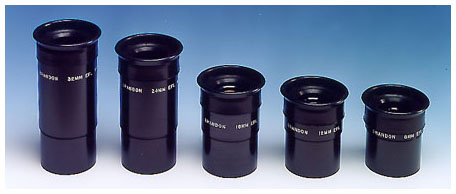 This article deals only with fixed focal length eyepieces. The top zoom eyepieces are described in detail in the article, Comparison: 8-24mm Zoom Eyepieces from Celestron, Meade, Tele Vue and Vixen. There are many different designs, or optical formulas, for oculars. Many are named for their original designer, famous opticians with last names such as Huyghens, Ramsden, Kellner, Plossl, Konig, Erfle, Branden and Nagler. Like camera lenses, inside of every ocular you will find a group or groups of individual lens elements. Oculars usually consist of two or more elements. Simple two element eyepiece designs are plagued by lateral color error (color fringing). Probably the best known two element optical formulas are the Ramsden and Huyghens, which date back to the 17th and 18th Centuries respectively. Two element oculars should be avoided. Achromatic oculars, such as the original three element Kellner design that uses a cemented, achromatic doublet eye lens, focus the long and short wavelengths of visible light, red and blue, to a common plane, but green light is not properly focused and typically creates a noticeable fringe of color around bright objects. Nevertheless, the Kellner design is much better corrected than the Ramsden or Huyghens. Similar in function to the Kellner design are the Modified Achromat (MA) and Super Modified Achromat (SMA) eyepieces from Meade. In practice, a fourth lens element is usually required to "bring it all together" and produce sharp views without intrusive lateral color and other aberrations. (All ocular designs have some residual aberrations, though.) The best eyepieces today incorporate a minimum of four elements in at least two groups in their design. Four element oculars are common and generally perform well. Orthoscopic and Plossl oculars are the most popular four element designs, while wide view Erfle type oculars use five elements. Some modern oculars incorporate more elements (up to eight) than the traditional designs for improved correction of aberrations, increased eye relief and a wider apparent field of view (AFOV). Often these eyepieces incorporate elements made of extra low dispersion (ED) glasses. The upscale Burgess/TMB Planetary (60-degree AFOV), Celestron Axiom LX (81-degree AFOV), Celestron Ultima LX (70-degree AFOV), Celestron X-Cel (55-degree AFOV), Meade Ultra Wide (84-degree AFOV), Orion Stratus (68-degree AFOV), Orion MegaView (82-degree AFOV), Tele Vue Ethos (100-degree AFOV), Tele Vue Nagler (82-degree AFOV), Tele Vue Panoptic (68-degree AFOV), Tele Vue Radian (60-degree AFOV) and Vixen Lanthanum-LVW (65-degree AFOV) ocular lines, to name a few of the better known brands, are examples of such eyepieces. These are priced higher than standard designs and they are available in a variety of focal lengths in both 1.25" and 2" size. However, more elements are not necessarily better in terms of brightness, sharpness and contrast. The more glass photons of light have to travel through on their way to your eye, the more light is absorbed, scattered and lost, decreasing brightness and contrast. Optical design is always a balancing act, an attempt to minimize flaws (aberrations and distortion) and maximize certain desirable characteristics, such as sharpness from center to edge, brightness, contrast, eye relief and a flat field. Different eyepiece designs do better in some areas than others and no design is perfect in all respects, so you have to choose the design that is most suitable for your intended purpose. The quality, care and precision of manufacture is also extremely important. Online specialty retailers, such as Optics Planet (www.opticsplanet.com), offer extensive eyepiece selections at a wide range of prices. Following, in alphabetical order, is a brief description of the most common eyepiece designs encountered today. Brandon Brandon eyepieces are manufactured by Vernonscope and sold directly, as well as by Questar. Questar supplies house brand Brandon oculars with its telescopes. Vernonscope offers 1.25" Brandon eyepieces in 8mm, 12mm, 16mm, 24mm and 32mm focal lengths. (These are pictured in the color photo at the top of this page.) The Brandon uses four elements in two groups. It is a symmetrical design similar to the Plossl with a 50-degree AFOV, but its optical properties are intended to mimic those of an Orthoscopic ocular. Brandons are sharp, flat field, highly corrected eyepieces with very low distortion and exceptionally high contrast. Like Plossls and Orthos, however, short focal length Brandons are lacking in eye relief. Interestingly, unlike other premium eyepieces, Vernonscope Brandon oculars are not multi-coated, although they are fully coated. The stated reason for this is to reduce narrow angle light scatter; multi-coatings increase narrow angle light scatter, which interferes with low contrast detail. Vernonscope has tried seven layer multi-coatings and their single layer anti-reflection coating works as well or better. Erfle Heinrich Erfle invented this design during the First World War. The basic Erfle uses five elements in three groups and delivers a wide apparent field of view of about 60-degrees. Erfle variations are also made with six elements in three groups, as in the diagram below. Erfles have a nice, flat field from edge to edge, although sharpness and contrast is slightly inferior to the Orthoscopic and Plossl designs. They also feature long eye relief, especially important for eyeglass wearers. 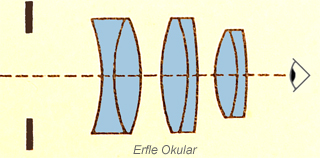 This combination of features makes these oculars excellent for wide sky viewing of open clusters, star fields, etc. They are usually found in focal lengths in the 18mm to 32mm range. I have used 1.25" Erfles in 24mm and 32mm focal lengths, where they give a greater field of view than Plossl type oculars. Erfle type oculars make excellent medium to low magnification eyepieces and today are often sold under proprietary names that do not credit Heinrich Erfle. Erfles are available in 1.25" and 2" size. Meade QX 1.25 and 2" oculars are probably the best known Erfles. 1.25" QX eyepieces are available in 15mm and 20mm focal lengths. Offering a similar apparent field in both sizes are the premium, 6-element designs called Super Wide Angle by the Meade Instrument Company, which fulfill the same role as traditional five element Erfles. In 1.25" diameter, the Meade Super Wide Angle oculars are available in focal lengths from 13.8mm to 24.5mm. Huyghens In the 1660's, Dutch astronomer Christian Huyghens designed a simple, two element eyepiece using a large, planoconvex field lens placed before the focus point of the telescope and a small planoconvex eye lens, separated by about half the sum of their focal lengths. The plain side of both elements faces the observer's eye and the image is formed between the two elements, making this a negative ocular. 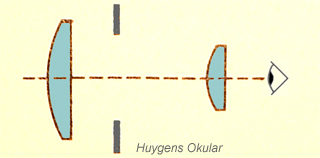 Huyghenian eyepieces have a restricted AFOV and there isn't a lot of eye relief. The small eye lens makes peering through high magnification Huyghenian oculars rather like looking through a pin hole. This design served its purpose in the 17th and 18th Centuries, but is obsolete today. Because they are inexpensive to make, Huyghens eyepieces are still sometimes provided with cheap, department store telescopes. Kellner (Achromat) Carl Kellner designed the first achromatic ocular in 1850. (Some sources report the date as 1863.) Along with the similar Meade Modified Achromat (MA), these are the least expensive practical oculars and are offered in focal lengths from about 6mm to 40mm. Kellners use three elements in two groups to minimize color fringing. However, some lateral color error is apparent when looking at bright subjects, such as Jupiter or Venus, against a dark sky. 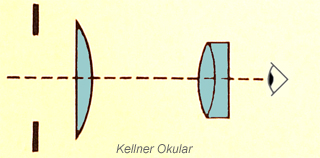 The design uses a planoconvex, two cemented-element eye lens and a large convex field lens. Kellner type oculars generally have an apparent field of view of about 40-degrees, with moderate eye relief. They have good center sharpness, but exhibit some field curvature and astigmatism. Edge sharpness is only so-so, as is the apparent field of view. They are most useful in medium and longer focal lengths for terrestrial, planetary and lunar viewing. Kellners are better than two element achromats, but clearly inferior to four element Ortho and Plossl oculars. They can, however, provide decent views with small telescopes. I have found the moderate 16mm to 25mm focal lengths to be the most useful among the Kellner oculars I have owned. Kellner and other three-element ocular designs are available in .96", 1.25" and 2" diameter oculars. Celestron used to supply Kellner oculars with their least expensive telescopes and still may. Konig Designed in 1915 by Albert Konig, the Konig eyepiece is similar to an Orthoscopic with a doublet field lens in place of the triplet. The original design allows for high magnification with excellent eye relief, the most eye relief proportional to focal length of any design prior to the introduction of Al Nagler's high magnification eyepieces. The Konig's apparent field of view is about 55-degrees. 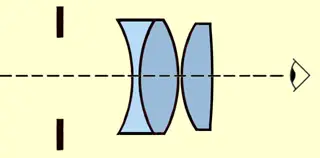 Modern versions of Konigs usually use lower dispersion glasses than were available to Albert during WW I and sometimes add more elements. The most common change is to add a positive, concave-convex element before the cemented doublet field lens, with the convex surface facing the doublet. These modernized Konigs offer 60 to 70-degree AFOV's and are usually sold under proprietary names that do not credit Konig as the original designer. Modified Achromat A three element ocular design used by Meade for the oculars they supply with their least expensive telescopes. Functionally similar to a Kellner ocular. Some chromatic aberration is apparent when looking at very bright subjects, such as Jupiter or Venus. They have a narrow apparent field of view of about 40 degrees and limited eye relief in the shorter focal lengths, which makes them difficult to look through. MA's are adequate starter oculars in medium and longer focal lengths, but it is best to replace MA's with Ortho, Plossl or other more sophisticated ocular designs when the opportunity arises. Monocentric Designed by Adolf Steinheil in 1883, this unusual eyepiece design uses three thick elements that are segments of concentric circles. The two outer elements are crown glass cemented to a flint glass center element. The result is a solid eyepiece with only two air to glass surfaces (the front and back). The Monocentric exhibits excellent brightness, contrast and freedom from ghost images. Unfortunately, the apparent field of view is very limited, about 25-degrees. However, this is not too much of a drawback when the Monocentric ocular is used for its intended purpose, which is viewing planetary and lunar details at high magnification.  The modern optician Thomas M. Back did considerable work improving Monocentric eyepieces by tweaking the design, using ED glass and low scatter anti-reflection coatings, ultimately creating the TMB Super Monocentric oculars for telescopes with focal ratios slower than f/6. This was intended to squeeze the absolute maximum contrast and sharpness possible from an eyepiece and Back was willing to sacrifice eye relief, AFOV and correction for off-axis astigmatism to achieve his goal. The result was a line of eyepieces beloved by serious planetary observers, but ignored by nearly everyone else. TMB Super Monocentric focal lengths included 4mm, 5mm, 6mm, 7mm, 8mm, 9mm, 10mm, 12mm, 14mm and 16mm. The AFOV was 32-degrees. The Super Monocentric eyepiece line was subsequently replaced by the current Burgess/TMB Planetary line, based on a totaly different design. Orthoscopic (Ortho) An apochromatic ocular design by Ernst Abbe' that uses four elements asymmetrically spaced in two groups with (unlike Plossl, Branden and Erfle oculars) crown glass elements outside of the flint glass elements. There is a single eye lens and the field lens is a three element cemented group. 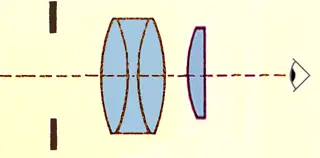 Well designed and manufactured Orthos are sharp, well corrected, flat field eyepieces. The Ortho was designed for very low pincushion and barrel distortion and it is a good design for viewing bright objects with a lot of detail. It is excellent for planetary and lunar viewing. Orthos typically have very good center sharpness with only a small amount of field curvature and astigmatism. Orthos with 1.25" diameter mounting barrels are usually available in focal lengths from about 4mm to 25mm. The drawbacks to Orthoscopic eyepieces are an AFOV of around 40 to 45-degrees and limited eye relief. Due to their restricted eye relief, Orthos are difficult for eyeglass wearers to use in focal lengths shorter than about 25mm and difficult for everyone in focal lengths shorter than about 10mm, unless you don't mind your eyelashes brushing the ocular lens. Despite their limited eye relief, I have enjoyed the tack sharp views provided by the Orthos I have owned. Perhaps because of its asymmetrical design, an Ortho is less susceptible to internal reflections (ghost images) than Plossl oculars. On the other hand, the 50-degree AFOV of Plossl oculars makes them a better choice for deep sky and all-around viewing. Plossl Designed by Georg Simon Plossl in 1860, the Plossl design has become the mainstay of the modern ocular business and probably represents the best value in terms of performance and price, especially in medium and long focal lengths. Celestron (Omni), Meade (Series 4000), Orion (Highlight), Tele Vue, Vixen (NPL) and others offer high quality Plossl oculars. Good Plossls are expensive to manufacture, because they require good optical glass and precisely matched concave and convex doublet surfaces to prevent internal reflections. All Plossl oculars are not created equal. 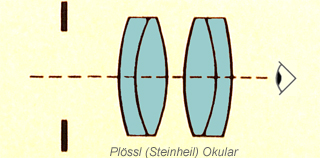 The Plossl optical formula uses four elements in two symmetrical, cemented pairs. Unfortunately, as alluded to in the paragraph above, this symmetry makes Plossl oculars susceptible to internal reflections when viewing bright objects at high magnification, so an internally blackened lens barrel with thread baffles is important, as are blackened lens edges and sophisticated anti-reflection multi-coatings. Inexpensive Plossls lacking these features deliver noticeably inferior views and are not a good value. If well made, Plossls are bright, contrasty, with a flat field, and excellent sharpness. Plossls are usually well corrected and offer about a 50-degree apparent field of view. This apparent field is wider than an Ortho or a Kellner, but not as wide as an Erfle or Radian. Their eye relief is limited to about 70-80% of their focal length. Plossls are available from many suppliers in a wide range of focal lengths in 1.25" and 2" sizes. The focal length range for 1.25" Plossls is about 6mm to 45mm. Plossl oculars are usually parfocal within a given manufacturer's line, which means that when one is in focus, they are all (at least approximately) in focus. Plossls provide adequate eye relief for eyeglass wearers in focal lengths of about 25mm and longer. Non-eyeglass wearers can usually tolerate Plossls as short as about 10-12mm before their eyelashes start brushing the ocular lens. Plossls are useful for most purposes, from short focal lengths designed for planetary views and splitting double stars, to long focal lengths designed for spectacular deep sky views. A 50-56mm Plossl in 2" diameter is spectacular for wide field, deep sky viewing. Telescope companies such as Celestron, Meade, Orion, Sky View, Stellarvue, Tele Vue and Vixen generally supply a 1.25" Plossl eyepiece with their better telescope packages. There are full length articles about Celestron Omni, Meade Series 4000 and Tele Vue Plossl eyepieces on the Astronomy and Photography Online home page. Ramsden Created by and named for the English mathematician Jesse Ramsden in the 1700's, this is a symmetrical two element design using two planoconvex elements (eye lens and field lens). The plain side of both elements faces outward and the image is formed between the eye element and the observer's eye, making the Ramsden design a positive ocular. 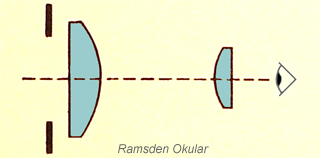 Both elements are made of crown glass and the Ramsden design was once popular with those who made their own eyepieces. Subject to lateral color error and substantial loss of sharpness at the edge of the field of view. Restricted AFOV, but longer eye relief than the Huyghens and Kellner designs. Reversed Kellner (RKE) Designed for Edmund Scientific in the late 1960's by David Rank, the RKE is a three element eyepiece that provides a somewhat greater AFOV than the traditional Kellner. It is known as a Reversed Kellner, because the configuration of the elements is reversed from that of the Kellner. 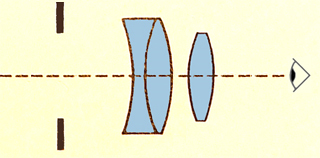 The RKE uses a single convex eye lens and a concave/convex cemented doublet field lens with the concave element facing the light source. A diagram of the RKE looks like a Konig with the two groups spaced farther apart. Tele Vue Nagler, Radian, Panoptic and Ethos Tele Vue's resident head optician is Al Nagler, one of the best known optical designers in the world today. These popular premium oculars incorporate various types of ED glass elements in their multi-element designs. The Tele Vue proprietary eyepieces include the Nagler, Radian, Panoptic and Ethos lines, all of which use more than four elements. Al Nagler formulated a short focal length eyepiece design that incorporates a pair of elements that essentially serve as a permanent, built-in Barlow lens (note the two elements that constitute the field group at the far left in the diagram below) and achieved an incredible 82-degree apparent field of view coupled with comfortable eye relief (12mm-19mm, depending on focal length, in current Nagler eyepieces). The Nagler eyepiece design has evolved over the years with the result that Nagler Type 4, 5 and 6 are the current versions. The Nagler Types 1, 2 and 3 have been discontinued. 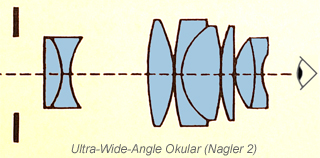 Nagler oculars are generally big and heavy and therefore often are not appropriate for small or compact telescopes. They contain six to eight elements in four or five groups. Introduced by Tele Vue in 1982, Naglers have become the "gold standard" for short oculars, especially in the 2" diameter mounting barrel size. Nagler ultra-wide designs are primarily used for short focal length (high magnification) applications, because short focal length necessitates short eye relief and tiny eye lenses in most conventional ocular designs. The Nagler design eliminates both of these drawbacks. Nagler Types 4, 5 and 6 are more compact than the original (hand grenade size!) Naglers and retain the 82-degree apparent field of the earlier types. Focal lengths run from 4.8mm to 16mm in 1.25" mounting barrels. There are also a couple of very short focal length Nagler zoom oculars, a 2-4mm and a 3-6mm. The Radian design incorporates six elements in four groups in focal lengths above 8mm and seven elements in five groups in the 6mm and shorter focal lengths. Radians have a uniform 60-degree apparent field of view and 20mm eye relief, regardless of focal length. They range in focal length from 3mm to 18mm, in 1.25" size only, and are primarily intended for medium to high magnification applications. Radian oculars offer full field sharpness with true orthoscopic linearity, high contrast and relatively compact size. They are a good choice for eyeglass wearers and are physically smaller than Tele Vue Nagler oculars. There is a full length article about Tele Vue Radian oculars on the Astronomy and Photography Online home page. Tele Vue's premium Panoptic oculars have a 68-degree apparent field, generous eye relief and are available in both 2" and 1.25" barrel diameters. Their optical design uses six elements in four groups. The Panoptic 41mm delivers the widest 2" AFOV possible. There are three focal lengths in the 1.25" size: 15mm, 19mm, 22mm and 24mm. The latter has the widest 1.25" actual FOV possible, equal to that of a 32mm Plossl with, of course, considerably greater magnification (but less brightness). Eye relief is approximately 70% of focal length. The Ethos line is the work of lead designer Paul Dellechiaie and has the widest apparent field of view among Tele Vue eyepieces, 100-degrees. It is also the most expensive. Ethos oculars feature low distortion, high contrast and very good center sharpness. They are intended for high magnification planetary observing. There are 21mm and 17mm Ethos eyepieces in 2" mounting barrels and 6mm, 8mm, 10mm and 13mm focal lengths in dual purpose 2"/1.25" mounting barrels. Eye relief is a constant 15mm for all Ethos oculars. These are very large oculars, weighing from about one pound to 2.25 pounds for the massive 2", 21mm Ethos. TMB Planetary II (Burgess/TMB Planetary) Designed by the late Thomas M. Back and marketed by both TMB Optical and Burgess Optical, these are apochromatic, flat field, low distortion, short focal length eyepieces with many of the advantages of an Orthoscopic ocular, but without the disadvantages. This was achieved by using modern design techniques and optical glasses. Contrast and sharpness are superb. The eye lens is sizeable and easy to look through and the eye relief is a comfortable 16mm for all focal lengths. The AFOV is a generous 60-degrees. The 9mm Planetary uses six elements, all other focal lengths use five elements. Here is an explanation of the reason for the Planetary eyepiece from Burgess Optical: "A planetary eyepiece is optimized to view bright objects while showing maximum detail and definition. It is an eyepiece with very high light transmission, very high contrast, minimal lateral color and minimal light scatter. For Dobsonian users and others without tracking drives, lateral color and other aberrations are minimized to allow the planet to drift across the field of view while still being sharp and having high contrast. Also, because lunar and planetary observers seek to see as much detail as possible, planetary eyepieces typically have a short focal length for high magnification." I replaced all of my short focal length Plossl and Ortho oculars with Burgess/TMB Planetary eyepieces and have never looked back. The available focal lengths are 2.5mm, 3mm, 4mm, 5mm, 6mm, 7mm, 8mm and 9mm. All are supplied with twist-up eyecups. |